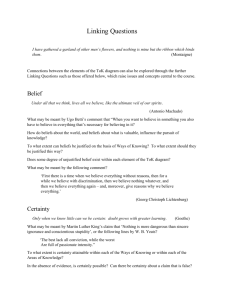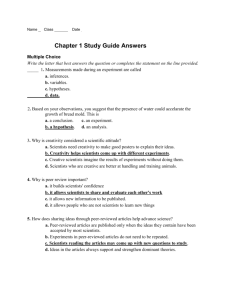Psychology & Science - Tutorial
advertisement
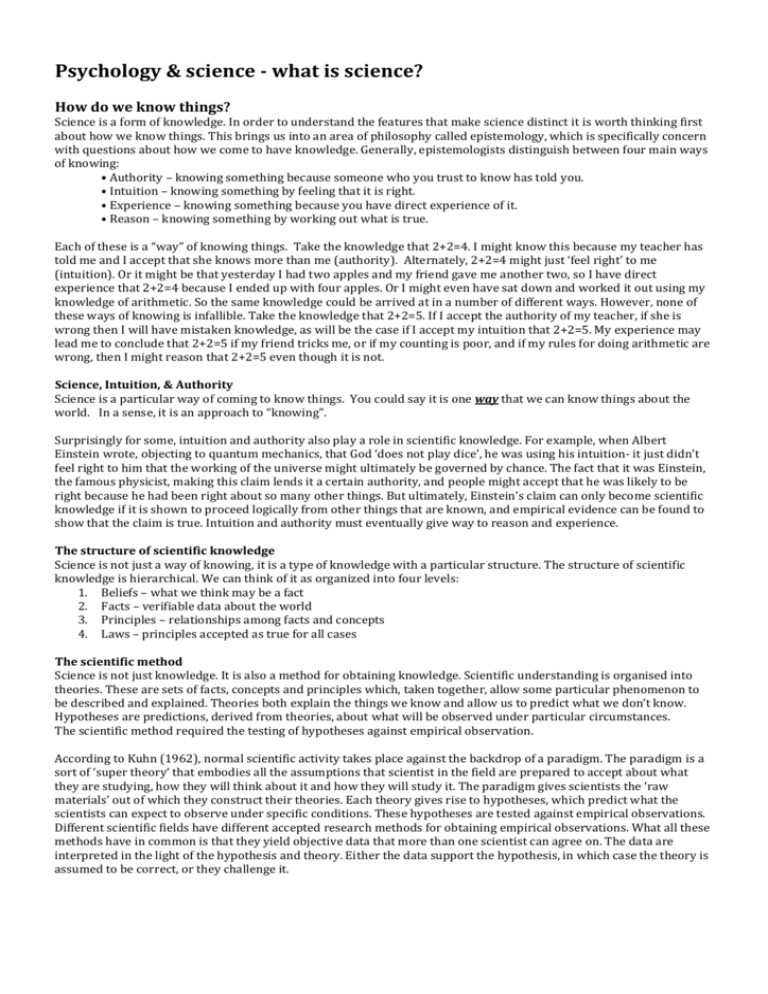
Psychology & science - what is science? How do we know things? Science is a form of knowledge. In order to understand the features that make science distinct it is worth thinking first about how we know things. This brings us into an area of philosophy called epistemology, which is specifically concern with questions about how we come to have knowledge. Generally, epistemologists distinguish between four main ways of knowing: • Authority – knowing something because someone who you trust to know has told you. • Intuition – knowing something by feeling that it is right. • Experience – knowing something because you have direct experience of it. • Reason – knowing something by working out what is true. Each of these is a “way” of knowing things. Take the knowledge that 2+2=4. I might know this because my teacher has told me and I accept that she knows more than me (authority). Alternately, 2+2=4 might just ‘feel right’ to me (intuition). Or it might be that yesterday I had two apples and my friend gave me another two, so I have direct experience that 2+2=4 because I ended up with four apples. Or I might even have sat down and worked it out using my knowledge of arithmetic. So the same knowledge could be arrived at in a number of different ways. However, none of these ways of knowing is infallible. Take the knowledge that 2+2=5. If I accept the authority of my teacher, if she is wrong then I will have mistaken knowledge, as will be the case if I accept my intuition that 2+2=5. My experience may lead me to conclude that 2+2=5 if my friend tricks me, or if my counting is poor, and if my rules for doing arithmetic are wrong, then I might reason that 2+2=5 even though it is not. Science, Intuition, & Authority Science is a particular way of coming to know things. You could say it is one way that we can know things about the world. In a sense, it is an approach to “knowing”. Surprisingly for some, intuition and authority also play a role in scientific knowledge. For example, when Albert Einstein wrote, objecting to quantum mechanics, that God ‘does not play dice’, he was using his intuition- it just didn’t feel right to him that the working of the universe might ultimately be governed by chance. The fact that it was Einstein, the famous physicist, making this claim lends it a certain authority, and people might accept that he was likely to be right because he had been right about so many other things. But ultimately, Einstein’s claim can only become scientific knowledge if it is shown to proceed logically from other things that are known, and empirical evidence can be found to show that the claim is true. Intuition and authority must eventually give way to reason and experience. The structure of scientific knowledge Science is not just a way of knowing, it is a type of knowledge with a particular structure. The structure of scientific knowledge is hierarchical. We can think of it as organized into four levels: 1. Beliefs – what we think may be a fact 2. Facts – verifiable data about the world 3. Principles – relationships among facts and concepts 4. Laws – principles accepted as true for all cases The scientific method Science is not just knowledge. It is also a method for obtaining knowledge. Scientific understanding is organised into theories. These are sets of facts, concepts and principles which, taken together, allow some particular phenomenon to be described and explained. Theories both explain the things we know and allow us to predict what we don’t know. Hypotheses are predictions, derived from theories, about what will be observed under particular circumstances. The scientific method required the testing of hypotheses against empirical observation. According to Kuhn (1962), normal scientific activity takes place against the backdrop of a paradigm. The paradigm is a sort of ‘super theory’ that embodies all the assumptions that scientist in the field are prepared to accept about what they are studying, how they will think about it and how they will study it. The paradigm gives scientists the ‘raw materials’ out of which they construct their theories. Each theory gives rise to hypotheses, which predict what the scientists can expect to observe under specific conditions. These hypotheses are tested against empirical observations. Different scientific fields have different accepted research methods for obtaining empirical observations. What all these methods have in common is that they yield objective data that more than one scientist can agree on. The data are interpreted in the light of the hypothesis and theory. Either the data support the hypothesis, in which case the theory is assumed to be correct, or they challenge it. When the empirical observations disagree with the hypothesis, a number of possibilities must be considered. It might be that the theory is incorrect, in which case it needs altering so it fully explains the data. Alternately it might be that the hypothesis was poorly derived from the original theory, in which case the scientists were expecting the wrong thing to happen. It might also be that the research was poorly conducted, or used an inappropriate method, or there were factors in play that the researchers did not consider. As a result, there may be considerable debate over the correct interpretation of a set of findings before their implications for theory are fully worked out. Checks and balances The scientific method aims to be self-correcting. That is, when errors happen, as inevitably they will, there are systems in place to ensure that the errors do not persist. One important check is replication. If one scientist uses a particular method to establish a particular finding, then any other scientist using the same method should be able to produce the same finding. Findings that cannot be replicated by anyone other than the original research tend to be rejected by the scientific community. A further check is peer review. Scientists make their findings public through the academic journals. Before publication, their work is checked (reviewed) by other scientists (their peers) to establish whether it stands up to scrutiny of the methods employed and the data obtained. The peer review process continues following publication as other scientists may respond to a published paper, publish their own research that supports or challenges it or even request data from the original researchers so claims and analyses can be checked. All these checks and balances ensure that errors are corrected and frauds detected as a matter of course and ultimately ensure that scientific research is honestly and rigorously conducted.
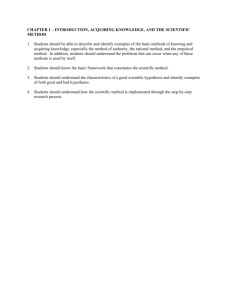

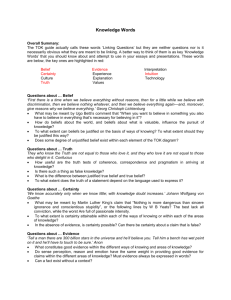

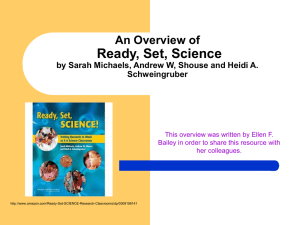
![Transformational Change [Powerpoint Presentation]](http://s2.studylib.net/store/data/005447411_1-da0a83bd34bdb90183940ab700125003-300x300.png)

